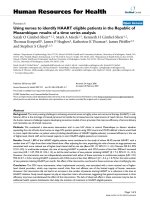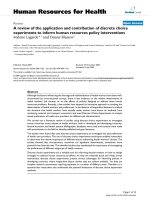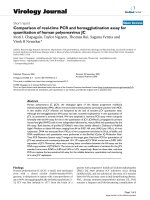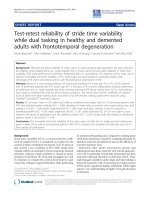06 Quantization of Discrete Time Signals
Bạn đang xem bản rút gọn của tài liệu. Xem và tải ngay bản đầy đủ của tài liệu tại đây (239.89 KB, 16 trang )
Ramachandran, R.P. “Quantization of Discrete Time Signals”
Digital Signal Processing Handbook
Ed. Vijay K. Madisetti and Douglas B. Williams
Boca Raton: CRC Press LLC, 1999
c
1999byCRCPressLLC
6
Quantization of Discrete Time
Signals
Ravi P. Ramachandran
Rowan University
6.1 Introduction
6.2 Basic Definitions and Concepts
Quantizer and Encoder Definitions
•
Distortion Measure
•
Optimality Criteria
6.3 Design Algorithms
Lloyd-Max Quantizers
•
Linde-Buzo-Gray Algorithm
6.4 Practical Issues
6.5 Specific Manifestations
Multistage VQ
•
Split VQ
6.6 Applications
Predictive Speech Coding
•
Speaker Identification
6.7 Summary
References
6.1 Introduction
Signals are usually classified into four categories. A continuous time signal x(t) has the field of real
numbers R as its domain in that t can assume any real value. If the range of x(t)(values that x(t) can
assume) is also R, then x(t)is said to be a continuous time, continuous amplitude signal. If the range
of x(t) is the set of integers Z, then x(t) is said to be a continuous time, discrete amplitude signal. In
contrast, a discrete time signal x(n) has Z as its domain. A discrete time, continuous amplitude signal
has R as its range. A discrete time, discrete amplitude signal has Z as its range. Here, the focus is
on discrete time signals. Quantization is the process of approximating any discrete time, continuous
amplitude signal into one of a finite set of discrete time, continuous amplitude signals based on a
particular distortion or distance measure. This approximation is merely signal compression in that
an infinite set of possible signals is converted into a finite set. The next step of encoding maps the
finite set of discrete time, continuous amplitude signals into a finite set of discrete time, discrete
amplitude signals.
A signal x(n) is quantized one block at a time in that p (almost always consecutive) samples are
taken as a vector x and approximated by a vector y. The signal or data vectors x of dimension p
(derived from x(n)) are in the vector space R
p
over the field of real numbers R. Vector quantization
is achieved by mapping the infinite number of vectors in R
p
to a finite set of vectors in R
p
. There is
an inherent compression of the data vectors. This finite set of vectors in R
p
is encoded into another
finite set of vectorsin a vector space of dimension q over a finite field (a field consisting of a finite set of
numbers). For communication applications, the finite field is the binary field (0, 1). Therefore, the
c
1999 by CRC Press LLC
original vector x is converted or compressed into a bit stream either for transmission over a channel
or for storage purposes. This compression is necessary due to channel bandwidth or storage capacity
constraints in a system.
The purpose of this chapter is to describe the basic definition and properties of vectorquantization,
introduce the practical aspects of design and implementation, and relate important issues. Note that
two excellent review articles [1, 2] give much insight into the subject. The outline of the article is
as follows. The basic concepts are elaborated on in Section 6.2. Design algorithms for scalar and
vector quantizers are described in Section 6.3. A design example is also provided. The practical
issues are discussed in Section 6.4. The multistage and split manifestations of vector quantizers are
described in Section 6.5. In Section 6.6, two applications of vector quantization in speech processing
are discussed.
6.2 Basic Definitions and Concepts
In this section, we will elaborate on the definitions of a vector and scalar quantizer, discuss some
commonly used distance measures, and examine the optimality criteria for quantizer design.
6.2.1 Quantizer and Encoder Definitions
A quantizer, Q, is mathematically defined as a mapping [3] Q : R
p
→ C. This means that the
p-dimensional vectors in the vector space R
p
are mapped into a finite collection C of vectors that are
also in R
p
. This collection C is called the codebook and the number of vectors in the codebook, N,
is known as the codebook size. The entries of the codebook are known as codewords or codevectors.
If p = 1, we have a scalar quantizer (SQ). If p>1, we have a vector quantizer (VQ).
A quantizer is completely specified by p, C and a set of disjoint regions in R
p
which dictate the
actual mapping. Suppose C has N entries y
1
, y
2
, ···, y
N
. For each codevector, y
i
, there exists
a region, R
i
, such that any input vector x ∈ R
i
gets mapped or quantized to y
i
.TheregionR
i
is
called a Voronoi region [3, 4] and is defined to be the set of all x ∈ R
p
that are quantized to y
i
.The
properties of Voronoi regions are as follows:
1. Voronoi regions are convex subsets of R
p
.
2.
N
i=1
R
i
= R
p
.
3. R
i
∩ R
j
is the null set for i = j.
It is seen that the quantizer mapping is nonlinear and many to one and hence noninvertible.
Encoding the codevectors y
i
is important for communications. The encoder, E,is mathematically
defined as a mapping E : C → C
B
. Every vector y
i
∈ C is mapped into a vector t
i
∈ C
B
where
t
i
belongs to a vector space of dimension q =log
2
N over the binary field (0,1). The encoder
mapping is one to one and invertible. The size of C
B
is also N. As a simple example, suppose C
contains four vectors of dimension p, namely, (y
1
, y
2
, y
3
, y
4
). The corresponding mapped vectors
in C
B
are t
1
=[00], t
2
=[01], t
3
=[10] and t
4
=[11]. The decoder D described by D : C
B
→ C
performs the inverse operation of the encoder.
A block diagram of quantization and encoding for communications applications is shown in
Fig. 6.1. Given that the final aim is to transmit and reproduce x, the two sources of error are due to
quantization and channel. The quantization error is x − y
i
and is heavily dealt with in this article.
The channel introduces errors that transform t
i
into t
j
thereby reproducing y
j
instead of y
i
after
decoding. Channel errors are ignored for the purposes of this article.
c
1999 by CRC Press LLC
FIGURE 6.1: Block diagram of quantization and encoding for communication systems.
6.2.2 Distortion Measure
A distortion or distance measure between two vectors x =[x
1
x
2
x
3
··· x
p
]
T
∈ R
p
and y =
[y
1
y
2
y
3
··· y
p
]
T
∈ R
p
where the superscript T denotes transposition is symbolically given by
d(x, y). Most distortion measures satisfy three properties given by:
1. Positivity: d(x, y) is a real number greater than or equal to zero with equality if and only
if x = y
2. Symmetry: d(x, y) = d(y, x)
3. Triangle inequality: d(x, z) ≤ d(x, y) + d(y, z)
To qualify as a valid measure for quantizer design, only the property of positivity needs to be sat-
isfied. The choice of a distance measure is dictated by the specific application and computational
considerations. We continue by giving some examples of distortion measures.
EXAMPLE 6.1:
The L
r
Distance
The L
r
distance is given by
d(x, y) =
p
i=1
|x
i
− y
i
|
r
(6.1)
This is a computationally simple measure to evaluate. The three properties of positivity, symmetry,
and the triangle inequality are satisfied. When r = 2, the squared Euclidean distance emerges and is
very often used in quantizer design. When r = 1, we get the absolute distance. If r =∞, it can be
shown that [2]
lim
r→∞
d(x, y)
1/r
= max
i
|x
i
− y
i
|
(6.2)
This is the maximum absolute distance taken over all vector components.
EXAMPLE 6.2:
The Weighted L
2
Distance
The weighted L
2
distance is given by:
d(x, y) = (x − y)
T
W(x − y)
(6.3)
where W is the matrix of weights. For positivity, W must be positive-definite. If W is a constant
matrix, the three properties of positivity, symmetry, and the triangle inequality are satisfied. In
some applications, W is a function of x. In such cases, only the positivity of d(x, y) is guaranteed to
hold. As a particular case, if W is the inverse of the covariance matrix of x, we get the Mahalanobis
distance [2]. Other examples of weighting matrices will be given when we discuss the applications
of quantization.
c
1999 by CRC Press LLC
6.2.3 Optimality Criteria
There are two necessary conditions for a quantizer to be optimal [2, 3]. As before, the codebook C
has N entries y
1
, y
2
, ···, y
N
and each codevector y
i
is associated with a Voronoi region R
i
.The
first condition known as the nearest neighbor rule states that a quantizer maps any input vector x
to the codevector closest to it. Mathematically speaking, x is mapped to y
i
if and only if d(x, y
i
) ≤
d(x, y
j
) ∀j = i. This enables us to more precisely define a Voronoi region as:
R
i
=
x ∈ R
p
: d
x, y
i
≤ d
x, y
j
∀j = i
(6.4)
The second condition specifies the calculation of the codevector y
i
given a Voronoi region R
i
.The
codevector y
i
is computed to minimize the average distortion in R
i
which is denoted by D
i
where:
D
i
= E
d
x, y
i
|x ∈ R
i
(6.5)
6.3 Design Algorithms
Quantizer design algorithms are formulated to find the codewords and the Voronoi regions so as to
minimize the overall average distortion D given by:
D = E[d(x, y)]
(6.6)
If the probability density p(x) of the data x is known, the average distortion is [2, 3]
D =
d(x, y)p(x)dx
(6.7)
=
N
i=1
R
i
d
x, y
i
p(x)dx
(6.8)
Note that the nearest neighbor rule has been used to get the final expression for D. If the probability
density is not known, an empirical estimate is obtained by computing many sampled data vectors.
This is called training data, or a training set, and is denoted by T ={x
1
, x
2
, x
3
, ···x
M
} where M
is the number of vectors in the training set. In this case, the average distortion is
D =
1
M
M
k=1
d
x
k
, y
(6.9)
=
1
M
N
i=1
x
k
∈R
i
d
x
k
, y
i
(6.10)
Again, the nearest neighbor rule has been used to get the final expression for D.
6.3.1 Lloyd-Max Quantizers
The Lloyd-Max method is used to design scalar quantizers and assumes that the probability density
of the scalar data p(x) is known [5, 6]. Let the codewords be denoted by y
1
,y
2
, ···,y
N
.Foreach
codeword y
i
, the Voronoi region is a continuous interval R
i
= (v
i
,v
i+1
]. Note that v
1
=−∞and
v
N+1
=∞. The average distortion is
D =
N
i=1
v
i+1
v
i
d
(
x,y
i
)
p(x)dx
(6.11)
c
1999 by CRC Press LLC
Setting the partial derivativesof D with respect to v
i
and y
i
to zero gives the optimal Voronoi regions
and codewords.
In the particular case when d(x,y
i
) = (x − y
i
)
2
, it can be shown that [5] the optimal solution is
v
i
=
y
i
+ y
i+1
2
(6.12)
for 2 ≤ i ≤ N and
y
i
=
v
i+1
v
i
xp(x)dx
v
i+1
v
i
p(x)dx
(6.13)
for 1 ≤ i ≤ N. The overall iterative algorithm is
1. Start with an initial codebook and compute the resulting average distortion.
2. Solve for v
i
.
3. Solve for y
i
.
4. Compute the resulting average distortion.
5. If the average distortion decreases by a small amount that is less than a given threshold,
the design terminates. Otherwise, go back to Step 2.
The extensionof the Lloyd-Max algorithm for designing vectorquantizers has been considered [7].
One practical difficulty is whether the multidimensional probability density function p(x) is known
or must be estimated. Even if this is circumvented, finding the multidimensional shape of the convex
Voronoi regions is extremely difficult and practically impossible for dimensions greater than 5 [7].
Therefore, the Lloyd-Max approach cannot be extended to multidimensions and methods have been
configured to design a VQ from training data. We will now elaborate on one such algorithm.
6.3.2 Linde-Buzo-Gray Algorithm
The input to the Linde-Buzo-Gray (LBG) algorithm [7] is a training set T ={x
1
, x
2
, x
3
, ···x
M
}∈
R
p
having M vectors, a distance measure d(x, y), and the desired size of the codebook N.From
these inputs, the codewords y
i
are iteratively calculated. The probability density p(x) is not explicitly
considered and the training set serves as an empirical estimate of p(x). The Voronoi regions are now
expressed as:
R
i
=
x
k
∈ T : d
x
k
, y
i
≤ d
x
k
, y
j
∀j = i
(6.14)
Once the vectors in R
i
are known, the corresponding codevector y
i
is found to minimize the average
distortion in R
i
as given by
D
i
=
1
M
i
x
k
∈R
i
d
x
k
, y
i
(6.15)
where M
i
is the number of vectors in R
i
. In terms of D
i
, the overall average distortion D is
D =
N
i=1
M
i
M
D
i
(6.16)
Explicit expressions for y
i
depend on d(x, y
i
) and two examples are given. For the L
1
distance,
y
i
= median
[
x
k
∈ R
i
]
(6.17)
c
1999 by CRC Press LLC









